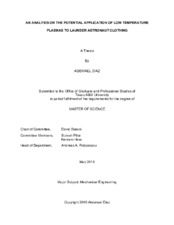| dc.description.abstract | Space laundry is non-existent onboard the ISS. Astronauts are forced to wear the same clothing for up to 3-5 days. After the clothing becomes soiled, it is discarded in resupply cargo ships. The discardment of soiled clothing requires periodic resupply ships to the ISS. According to 2008 NASA contract prices with SpaceX, the launch cost per lb of mass is approximately $18,000. A crew of 6 astronauts needs approximately 900 lbs of clothing per year. With planned 3-year long missions to Mars, this equates to a total cost of 48.6 million dollars. A space laundry system is needed to make interplanetary travel sustainable. Plasmas are a gaseous mixture of ions, electrons, neutrals, radicals, and photons, and have well documented successes in bacterial disinfection and odor control. Non-equilibrium plasmas are suitable candidates for the laundering of soiled astronaut clothing in space since they occupy minimal space, use zero water, and only need two resources: 10W of power and atmospheric pressure. These two resources are readily available on the ISS. Our research has shown that DBD plasmas and low pressure plasmas are potentially capable of laundering clothing in space. Results show that a 10- min, 1.27 W/cm² DBD plasma can provide an E.coli CFU log reduction of 2.7, can reduce the concentration of an actual body odor molecule (isovaleric acid) by 92%, and can do this while causing minimal visible damage to the fabric. In addition, a 4-5 min 0.016 W/cm² LPPR plasma can provide an E.coli CFU log reduction of up to 1.03, and can do so without negatively affecting either the tensile strength or ductility of the treated merino wool or causing any changes to their microstructure. These results are evidence that a plasma-based laundering system is a working concept. Following proper design and development processes, these plasma technologies could have tremendous cost-savings potential for deep space exploration missions. By simply doubling the wearability of clothing, the cost of launching to Mars could decrease by millions of dollars. | en |


